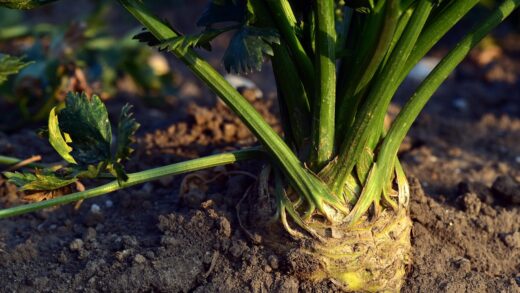Garlic is a demanding crop with a voracious appetite, and meeting its specific nutrient requirements through a well-planned fertilisation strategy is essential for cultivating large, dense, and flavourful bulbs. Its long growing season, which spans from autumn through the following summer, means that it needs a sustained supply of nutrients to fuel its various growth stages, from initial root establishment to vigorous vegetative growth and final bulb development. A deficiency in any key nutrient at a critical stage can irrevocably limit the plant’s potential, resulting in a diminished harvest. Therefore, a proactive approach to soil fertility, combining pre-plant soil enrichment with timely supplemental feeding, is the cornerstone of successful garlic nutrition.
The nutritional journey of garlic begins with the soil itself, which should be viewed as a nutrient bank for the crop. Before a single clove is planted, the soil should be generously amended with high-quality organic matter, such as well-rotted compost or aged manure. This organic matter serves multiple functions: it provides a slow-release source of a wide spectrum of macro- and micronutrients, improves soil structure for better root growth, and enhances the soil’s ability to retain both water and nutrients. This foundational fertility is what sustains the garlic plant through the autumn and winter, allowing it to establish a strong root system and prepare for the demands of spring growth.
Of the primary macronutrients—nitrogen, phosphorus, and potassium (N-P-K)—garlic has a particularly high demand for nitrogen, especially during its spring growth spurt. Nitrogen is a critical component of chlorophyll and is directly responsible for the lush, green foliar growth that is necessary to power the process of photosynthesis. This photosynthetic engine is what creates the energy that will eventually be stored in the bulb. A lack of nitrogen during this vegetative phase will result in yellowing leaves, stunted growth, and ultimately, smaller bulbs, as the plant will lack the foliar “factory” to produce a large product.
While nitrogen is crucial for leaf growth, phosphorus and potassium play equally important, albeit different, roles. Phosphorus is vital for strong root development, particularly in the early stages of the plant’s life, and is also essential for energy transfer within the plant. Potassium contributes to overall plant vigour, disease resistance, and is critically involved in the process of bulb formation and the storage of carbohydrates. A balanced fertilisation program must therefore address not only the high demand for nitrogen but also ensure an adequate supply of phosphorus and potassium to support the entire life cycle of the plant.
Understanding macronutrients and micronutrients
The nutritional needs of garlic are complex, requiring a balance of both macronutrients and micronutrients. The primary macronutrients, needed in the largest quantities, are nitrogen (N), phosphorus (P), and potassium (K). Nitrogen is the engine of vegetative growth, directly fueling the development of the leaves. A healthy, green canopy is essential for maximizing photosynthesis, which in turn provides the energy needed to form a large bulb. The plant’s demand for nitrogen is highest in the spring, during its period of most rapid leaf production.
Phosphorus (P) is the second key macronutrient, playing a crucial role in root development, energy transfer (through ATP), and cell division. An adequate supply of phosphorus is especially important in the early stages after planting to ensure the clove establishes a robust root system before winter dormancy. Strong roots are the foundation for a healthy plant and are essential for efficient water and nutrient uptake. Later in the season, phosphorus continues to support the energy-intensive process of bulb development.
Potassium (K), the third primary macronutrient, is an all-around contributor to plant health and productivity. It is involved in regulating water movement within the plant, activating enzymes, and enhancing stress tolerance and disease resistance. For garlic, potassium is particularly important during the bulbing stage, as it aids in the transport and storage of sugars and starches from the leaves to the developing bulb. A sufficient supply of potassium leads to denser, heavier bulbs with improved storage quality.
Beyond the big three, garlic also requires secondary macronutrients like sulfur, calcium, and magnesium, as well as a range of micronutrients in smaller quantities, including boron, zinc, and manganese. Sulfur is especially noteworthy for garlic, as it is a key component of the sulfuric compounds that give garlic its characteristic pungent flavour and aroma. Most fertile soils rich in organic matter will contain an adequate supply of these micronutrients, but a comprehensive soil test can identify any specific deficiencies that may need to be addressed with targeted amendments.
Pre-planting fertilisation
The most effective fertilisation strategy for garlic begins well before the cloves are even planted. Building a fertile soil foundation is paramount, as this provides a baseline of nutrition that the plants can access throughout their entire growth cycle. The single most important pre-planting amendment is a generous application of well-finished organic matter. Spreading a two- to four-inch layer of high-quality compost or well-rotted manure over the planting area and incorporating it into the top six to eight inches of soil provides a wealth of benefits beyond just nutrients, including improved soil structure and water retention.
In addition to compost, it is often beneficial to add a balanced, slow-release granular fertilizer to the bed during preparation. This ensures that a reserve of essential nutrients, particularly phosphorus and potassium, is available in the root zone from the very beginning. An ideal pre-plant fertilizer will have a balanced N-P-K ratio or one that is slightly higher in phosphorus to promote strong initial root growth. Organic options for this include bone meal for phosphorus and greensand or kelp meal for potassium and trace minerals.
Conducting a soil test prior to planting is a highly recommended step for any serious grower. A soil test provides precise data on the current pH and the levels of all major and minor nutrients in your soil. This information allows you to move from guessing to making informed decisions about which specific amendments are needed. For example, if the test reveals a significant phosphorus deficiency, you can add a concentrated source like bone meal, or if the soil pH is too acidic, you can incorporate lime to raise it to the optimal range of 6.0 to 7.0 for garlic.
The goal of pre-planting fertilisation is to create a nutrient-rich environment that will sustain the garlic through its initial establishment phase in the autumn and winter. By “charging” the soil with a combination of slow-release organic matter and balanced fertilisers, you ensure that the cloves have everything they need to develop a vigorous root system. This strong foundation is what enables the plant to emerge in the spring with the strength and resources necessary for the demanding period of rapid vegetative growth that lies ahead.
Top-dressing during spring growth
As garlic emerges from winter dormancy and begins its period of rapid vegetative growth in the spring, its demand for nutrients, especially nitrogen, increases dramatically. The foundational fertility provided by pre-plant amendments will begin to be depleted, necessitating supplemental feeding, commonly known as top-dressing or side-dressing. This practice involves applying fertiliser to the surface of the soil around the plants, where it can be watered in and carried down to the root zone. Timing this application correctly is crucial to support the development of a large, healthy plant canopy.
The first application of top-dressing should typically occur once the garlic shoots have reached about six inches in height. A nitrogen-rich fertiliser is the ideal choice for this stage. Excellent organic options include blood meal, which is a fast-acting source of nitrogen, or feather meal, which releases its nitrogen more slowly over time. A liquid feed, such as fish emulsion or compost tea, can also be used and has the advantage of being immediately available to the plants. This initial boost of nitrogen fuels the production of lush, green leaves.
Subsequent applications of top-dressing can be made every three to four weeks throughout the spring. The goal is to provide a steady, consistent supply of nitrogen to maintain vigorous foliar growth. It is important to monitor the plants for signs of their nutritional status. Healthy, well-fed garlic will have a deep green colour. If the leaves, particularly the lower ones, begin to turn yellow, it is often a sign of nitrogen deficiency, indicating that it is time for another feeding.
All nitrogen fertilisation must cease as the plant begins its transition from vegetative growth to bulb formation. This typically occurs in early to mid-summer, and a key indicator for hardneck varieties is the emergence of the flower stalk, or scape. Continuing to apply nitrogen at this stage would encourage the plant to keep producing leaves at the expense of bulb size. It can also lead to softer bulbs that do not store well. The focus of the plant’s energy must shift from its top to its bottom, and ending the nitrogen supply is the primary signal for this transition.
Identifying and correcting nutrient deficiencies
Vigilant observation of your garlic patch can help you identify potential nutrient deficiencies before they severely impact the crop. The most common deficiency seen in garlic is a lack of nitrogen. This typically presents as a uniform yellowing (chlorosis) of the plant’s leaves, starting with the oldest, lowest leaves and progressing upwards. This is because nitrogen is a mobile nutrient within the plant, and the plant will move it from the old leaves to the new growth. If you see this symptom during the spring growth phase, a quick application of a nitrogen-rich fertiliser is needed.
A phosphorus deficiency, while less common, can also occur, particularly in cold or overly acidic soils. Symptoms include stunted growth and leaves that may take on a dark, almost purplish or reddish hue. Since phosphorus is most critical for root development, a deficiency early in the season can have lasting negative effects on the plant’s ability to take up other nutrients and water. Correcting a phosphorus deficiency is best done before planting by incorporating sources like bone meal or rock phosphate into the soil.
Potassium deficiency often manifests as a yellowing or browning along the margins or tips of the older leaves, while the base of the leaf remains green. The plants may also appear less vigorous and be more susceptible to disease and environmental stress. A lack of potassium can directly impact the size and density of the final bulb. Sources of potassium include kelp meal, greensand, or sulfate of potash, which can be applied as a top-dressing if a deficiency is identified.
It is important to remember that symptoms like yellowing leaves can also be caused by factors other than nutrient deficiencies, such as overwatering, underwatering, or disease. Therefore, it is crucial to assess the overall growing conditions before jumping to conclusions. A soil test remains the most reliable tool for diagnosing nutrient issues accurately. By combining regular observation with occasional soil testing, you can ensure your garlic crop receives the balanced diet it needs to thrive and produce an abundant harvest.
















